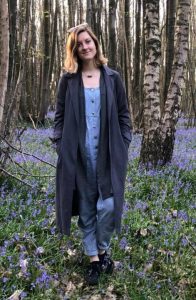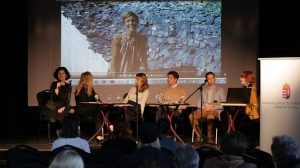
The author of this post: Helen Russell Brown
On the 5th October 2018, only two weeks into my journey with The Universal Sea, I found myself following this incredible initiative to Budapest to take part in a pioneering creative ‘hackathon’ and attend The Universal Sea – Conference on Art and Sustainability, created in partnership with Art Moments Budapest and HybridArt. Majestically poised on the Danube river just a stones throw from the houses of parliament, floating venue Trip Hajó was a perfectly poignant setting for our day of speakers, presentations, and round table discussions about water pollution.
Wow, what a stimulating introduction to the incredible work of not only The Universal Sea project, but the many inspirational academics, scientists, artists, entrepreneurs, educators, ambassadors, and all variety of wonderful humans already dedicated to finding a better future for us all.
After being welcomed by Dr. Tamas Szucs (European Commission) and Dr. Martina Makai (National Development Ministry), we were propelled into the morning with a captivating opening presentation from Réka Hunyadi of activist group Greenpeace, who had the clear message: Be the change you wish you see in the world. Listening to stories of this unique brand of activist energy and motivation, it is clear to see the effectiveness of their public interventions based on artistic strategies. The sheer passion and drive of Greenpeace to create social awareness and ultimately positive change was utterly galvanizing.
Sitting eagerly in the front row I heard colleague and project leader Nicole Loeser speak publicly about The Universal Sea project. Listening to the motivations and goals carrying this passion for clean water, I realised with a sudden clarity that my own artistic practice share the same through-line: art as a catalyst for change. The power of visual communication to convey a simple message quickly and effectively, Nicole explains, is at the heart of this perspective.
Shifting into a round table discussion with a selection of TUS artists in residence, rediscovering the role of the artist became our first topic of the day. How can we encourage people to drop the attitude ‘Not my fault, not my problem’? How might we then all take responsibility for the consumer choices we make? These questions drew answers that highlighted the role of the artist in society as one with the potential for great power and responsibility. In the context of this conversation about plastic pollution of our waters, the power given through creative expression was not one that our artists took lightly. While feeling empowered by art that inspires activism, it is easy to forget the vast amount of artworks that exist with little to no impact; what if all this creative energy could be channeled into good causes? Should art and creativity be focused this way? Artist Frankie Moughton-Small spoke in particular about the volume of aesthetic and decorative art that exists, expressing anger at thoughtless creations often produced by young artists during their training. The group all talked about the importance of involving children; that an adult’s mind is harder to change than a child. Perhaps this particular form of creative activism should be more focused towards engaging our little ones.

Blown away by the facts presented by Gabor Bordós of water research Group Wessling, the evidence of microplastic in every sample taken from rivers all over central Europe brought the alarming truth that the plastic epidemic is advanced far beyond the knowledge of the general public. But how can we combine different perspectives in order to fight plastic pollution? It is clear listening to many different voices throughout the day that the common motivation towards clean water is articulated through a whole host of vocational languages; art, science, technology, innovation, community activism to name but a few. We are all universally connected by this issue, but how to tackle it together? The second round table of the day ‘Art and Innovation’ offered many thoughts on exactly this predicament- how can different schools of thought join forces for effective progression? The answer felt by many, was the need for some kind of mediator. It should not be that one practice bends to another- in recognition of the importance of the autonomy of different professions- but that we need someone, or something to bridge that gap. Cue everyone referring to the importance of the facilitation of organisations such as The Universal Sea.
Socially engaged art on this matter should not be about creating awareness- we all know that there is a problem with plastic. Instead it should be about creating agency. This opinion offered by Prof. Dr. Kaethe Wenzel during our third round table about socially engaged art, was felt by many in the audience. We must empower, not just encourage, but we also need the topic to become more sexy; we need contemporary influencers to get involved. Ede Sinkovics, also involved in TerraCycle, added to this conversation by explaining that his art aims to engage by shocking a public audience. Influenced by the beauty of an artwork made entirely from garbage, the realisation of such can immediately get under the skin of the public.
In the final discussion about reaching and involving the public, artists Erika Kraponczai and Julia Végh joined the panel to present their perspective on bringing art into the public realm. With their impressive public square installation Plastic Waste Labyrinth, they witnessed the authentic emotional exchange with visitors passing through the space. By bringing these huge cubes of plastic waste into a public space, the effect was to undeniably connect this unseen environmental issue to the public consciousness.
Coming from a background working in food waste, this acute introduction to the plastic pollution epidemic, delivered with such insight and passion, felt like I had struck right into the heart of this activist movement. Sitting in the belly of a converted ship surrounded by great minds, while just beyond lay the steely expanse of the Danube, this underwater capsule of intellect and energy felt like a momentary and quintessential nucleus of The Universal Sea and everything it stands for.
Full program and speaker’s list HERE
